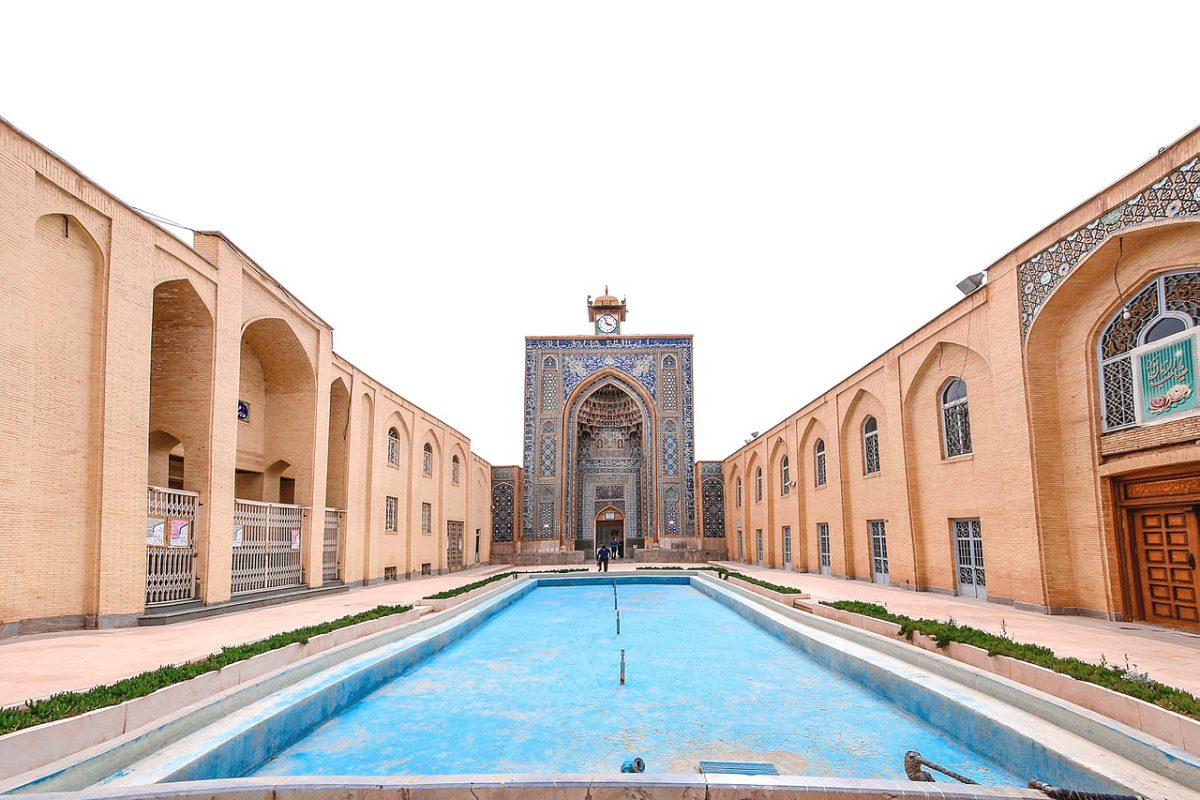Table of Contents
The Jame Mosque of Kerman, also known as the Mozaffari Mosque, stands as a testament to the grandeur of Persian architecture. Erected in 750 AH by Amir Mobarezeddin Mohammad-e-Mozaffari-e-Meybodi Yazdi, this ancient structure is a significant remnant from the era following the Al-e-Booyeh dynasty.
The Mozaffari Mosque is a masterpiece of symmetry, designed with both winter and summer porches to accommodate worshippers throughout the year. This balanced architectural approach not only enhances the mosque’s aesthetic appeal but also underscores the ingenuity of its builders in creating a space that is both functional and visually stunning. The mosque’s design and construction reflect the sophistication of Iranian monarchs, making it a true gem among the historical landmarks of the region.
Jame Mosque of Kerman History
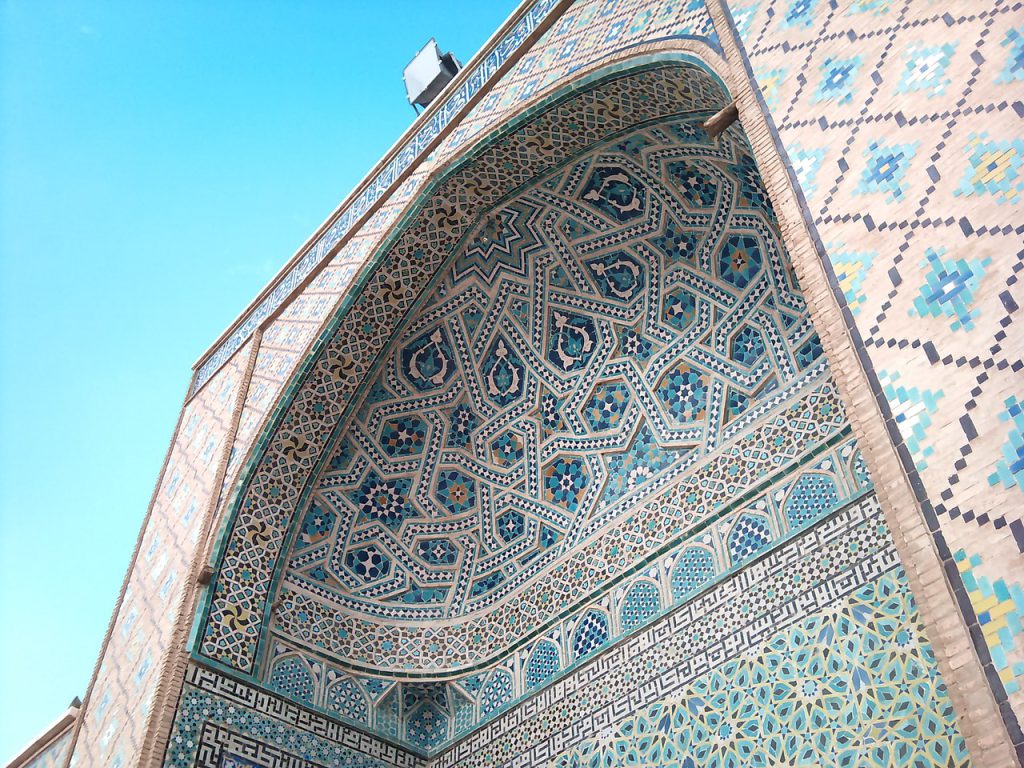
The Jame Mosque of Kerman owes its inception to the mid-fourteenth century, around 1349, during the reign of Amir Mobaraz al-Din Muhammad Mozaffari Meybodi, a ruler of the Muzaffarid dynasty. This majestic mosque, now 700 years old, was initially constructed outside the boundaries of Kerman. Over time, the city expanded, gradually enveloping this architectural gem within its embrace, turning it into a central part of Kerman’s historical fabric.
The story behind the mosque’s creation is intertwined with a fierce battle against the Turkic tribes of Jerman and Oghan. Determined to leave a lasting legacy if he survived the conflict, Amir Mozaffari resolved to build a grand mosque. Upon emerging victorious, he turned his focus to this monumental project, funding the construction with the income from his agricultural ventures in Meybod. Thus, the foundation of this enduring masterpiece was laid, symbolizing both triumph and devotion.
Reconstruction
The Kerman Jame Mosque has faced numerous challenges over the centuries, with significant restorations marking its resilience. Shahrokh Nami restored the mosque during Shah Abbas II’s reign, and in 1763, Mohammad Taghi Khan Durrani, the ruler of Kerman, undertook further renovations. These efforts were crucial in preserving the mosque, especially given the repeated damage it endured.
In October 1978, during political unrest, the mosque was set on fire by forces linked to the Pahlavi government, leading to a tragic loss of life and prompting another round of reconstruction. Despite these setbacks, the mosque’s beauty endures, thanks to the contributions of architects like Inayatullah Ibn Nizamuddin of Isfahan, whose work on the grand Iwan remains a testament to the mosque’s lasting significance.
Jame Mosque of Kerman Architecture
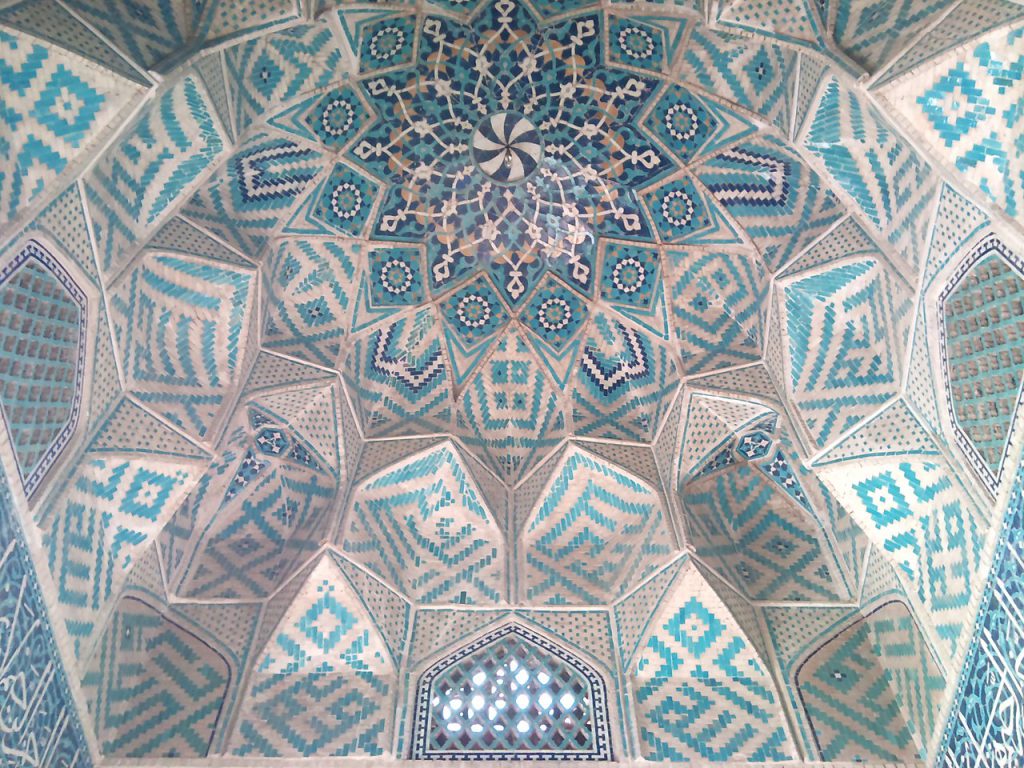
The Jame Mosque of Kerman, a relic from the era following the Al-e-Booyeh dynasty, stands as one of Iran’s most enduring architectural marvels. Its eastern gateway, towering and majestic, captures attention with intricate tile work that speaks to the artistic craftsmanship of the time. This entrance is further accentuated by a clock tower, adding a touch of grandeur to the historic structure.
The mosque’s design is a testament to symmetrical beauty, meticulously constructed to cater to the varying needs of the seasons. With distinct porches for winter and summer, the mosque exemplifies thoughtful architectural planning, ensuring comfort and functionality year-round.
Jame Mosque of Kerman in Iran National Heritage List
Jame Mosque of Kerman or Kerman Grand Mosque, also known as the Mozaffari Grand Mosque, is a true gem in the tapestry of Iran’s architectural heritage. This venerable structure, with roots tracing back through the centuries, has been officially recognized as a national treasure, solidifying its place in the country’s cultural legacy.
The mosque’s inclusion on Iran’s National Heritage List is a testament to its profound historical significance and the remarkable craftsmanship that went into its construction. Each intricate detail, from the ornate tile work to the soaring minarets, speaks to the skill and dedication of the artisans who brought this architectural masterpiece to life. The mosque’s timeless design and impressive scale have captivated visitors for generations, serving as a constant source of pride and inspiration for the people of Kerman and all of Iran.
How to Get to Jame Mosque of Kerman
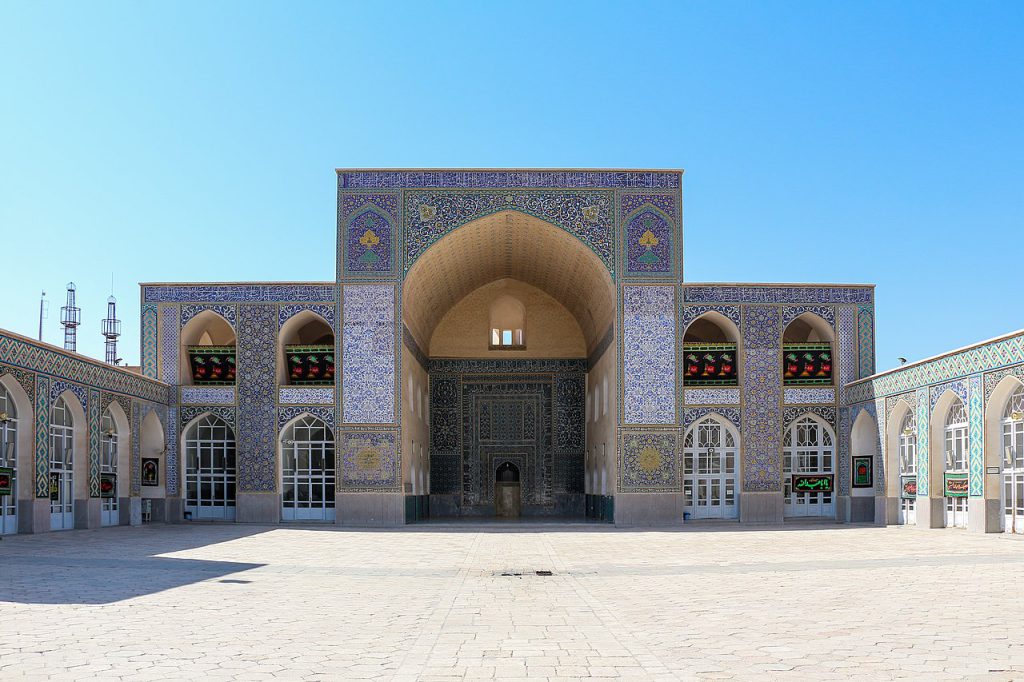
To reach Shohada Square, also known as Moshtaq Square, in Kerman, you can opt for various transportation in Iran methods.
Once you arrive at Shohada Square, you’ll be greeted by the lively atmosphere of the surrounding bazaar, where local vendors display their crafts and delicious street food beckons to passersby. From Shohada Square, the Jameh Mosque of Kerman is just a short walk away.
Working Hours of Jame Mosque of Kerman
The Jame Mosque of Kerman welcomes visitors daily from 08:00 to 20:00, offering ample time to explore its historical and architectural wonders.
Whether you’re an early riser eager to start your day with a peaceful visit or someone who prefers a later stroll, the mosque’s accommodating hours ensure you can experience its beauty at your own pace.
Recommended Sightseeing Time of Jame Mosque of Kerman
Spending about an hour at the Jame Mosque of Kerman is the perfect amount of time to fully appreciate its intricate details and rich history. In this hour, you can leisurely explore the mosque’s stunning architecture, from its majestic entrance to the beautifully adorned prayer halls.
Where to Eat Near Jame Mosque of Kerman
Meysam Khan
Meysam Khan is a popular restaurant located in Kerman, known for its vibrant atmosphere and delicious Persian cuisine. The establishment offers a diverse menu that features traditional dishes, including various kebabs, stews, and rice dishes, all prepared with fresh, locally sourced ingredients. The inviting decor, often adorned with Persian motifs, creates a warm and welcoming environment, making it an ideal spot for both locals and tourists seeking an authentic dining experience. The staff is known for their friendly service, ensuring that every guest feels at home while enjoying their meal.
Kerman Max Restaurant
Kerman Max Restaurant is a highly-rated dining establishment located in Kerman. Situated at 72PW+8F8, Kerman, this restaurant offers a welcoming atmosphere where guests can enjoy a variety of delicious dishes. Kerman Max caters to both lunch and dinner crowds, making it a convenient choice for those exploring the area or visiting nearby attractions.
Where to Stay Near Jame Mosque of Kerman
Yas Guesthouse
For budget-conscious travelers, Yas Guesthouse stands out as a fantastic option. This guesthouse is celebrated for its cleanliness and friendly ambiance, providing a welcoming retreat for those eager to explore Kerman without overspending. Guests can enjoy the convenience of nearby local restaurants and shops, making it easy to immerse themselves in the vibrant culture of the city. The guesthouse features spacious twin rooms, a large communal lounge, and a well-equipped kitchen, ensuring a comfortable stay for all.
Narenj Hostel
Another excellent choice for budget travelers is Narenj Hostel, which fosters a sociable environment perfect for meeting fellow adventurers. This hostel offers basic amenities in a cozy setting, catering specifically to backpackers and those looking for economical accommodations. With its friendly atmosphere and opportunities for social interaction, Narenj Hostel is ideal for those who want to share travel stories and experiences while enjoying their time in Kerman.
Other Attractions Near Jame Mosque of Kerman
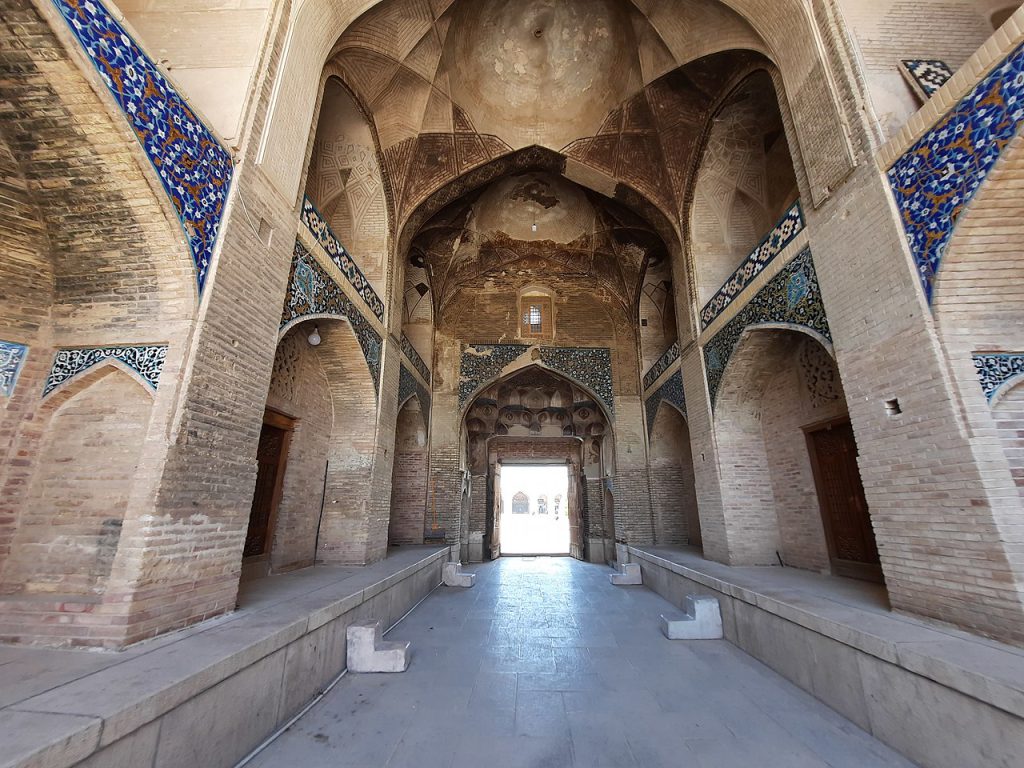
Ganjali Khan Complex
Nestled in the heart of historic Kerman, the Ganjali Khan Complex stands as a captivating testament to the legacy of one of the region’s most influential figures. This architectural marvel, commissioned under the reign of King Abbas from 1596 to 1625, bears the indelible mark of Ganjali Khan’s visionary leadership.
As you wander through the intricate network of structures, you’ll be transported back in time, marveling at the intricacy of the design and the seamless integration of form and function. From the bustling bazaar to the serene courtyards, every corner of this complex reveals the meticulous planning and attention to detail that Ganjali Khan instilled in his ambitious undertaking. The complex’s enduring significance extends beyond its architectural splendor, serving as a testament to the pivotal role this esteemed ruler played in the regional development of Kerman.
FAQs about Jame Mosque of Kerman
Q1: Who built the Jame Mosque of Kerman?
A1: The Jame Mosque of Kerman was built by Amir Mobaraz al-Din Muhammad Mozaffari.
Q2: How old is the Jame Mosque of Kerman?
A2: The Jame Mosque of Kerman is about 700 years old, built around 1349.
Q3: What makes the Jame Mosque of Kerman special?
A3: The mosque is special for its beautiful and symmetrical architecture, including separate porches for winter and summer.
Q4: Where is the Jame Mosque of Kerman located?
A4: The Jame Mosque of Kerman is located near Shohada Square (Moshtaq Square) in Kerman, Iran.
Q5: What are the visiting hours for the Jame Mosque of Kerman?
A5: The mosque is open daily from 08:00 to 20:00.
Last Words: Explore the Best of Jame Mosque of Kerman with a Customized Tour
The Jame Mosque of Kerman, also called the Mozaffari Mosque, is a great example of Persian architecture. Built in 750 AH by Amir Mobarezeddin Mohammad-e-Mozaffari-e-Meybodi Yazdi, it is an important structure from the time after the Al-e-Booyeh dynasty. The architecture reflects the sophistication of Iranian rulers, making it a key historical landmark in the region.
For those eager to explore the Jame Mosque of Kerman and immerse themselves in Iran’s rich heritage, opting for Customized tours is the best way to ensure a personalized and unforgettable experience. To Iran Tour is a leader in crafting Iran tours and travel packages, carefully designed to align with your interests and preferences. Whether you’re captivated by Islamic architecture, history, or culture, our Iran Tours are meticulously planned to offer you the most enriching journey.
We’re here to help you make the most of your visit to Iran, ensuring every moment is memorable.

